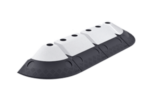| PROJECT NAME: | Paving works and implementation of the bike lane in the street of Bori i Fontestà |
| CITY: | Barcelona, Spain |
| LOCATION: | Bori i Fontestà Street |
| OPENING DATE: | April 2018 |
Barcelona is adapting its urban space to distribute it more evenly between the different modes of transport, opening up traffic spaces for bicycles, improving the bus network, and giving priority to people traveling on foot, with the extension of sidewalks and the pacification of streets that offer comfort and safety. The expansion of the network of cycle paths is one of the star measures of the City Council to achieve this adaptation. The ultimate goal is to increase the kilometers of bike path substantially so that 95% of the city’s population has at least one bike path less than 300 meters away from their home.
Need and project objectives.
Bori i Fontestà street had a classic design that offered a lot of space to the private motorized vehicle and little or no space or safety to bicycle users. The Barcelona City Council decided in 2017 to include this street in the cycle route connecting the Gràcia district with the University Zone, through the Sarrià district. The objectives of the project were:
- To reduce air and noise pollution from motor transport.
- To promote cycling and improve the safety of cyclists on the street.
The proposed solution.
The Barcelona City Council opted for the creation of a bidirectional cycle path that is located in the center of the road. For the segregation of this lane, the modules of the Zipper® system of ZICLA were used. This system is modular and its modules can be installed continuously or discontinuously, allowing multiple configurations to be built.
 The Zipper® system is mainly characterized by:
The Zipper® system is mainly characterized by:
- It can be adapted to any kind of road, particularly avenues.
- It is highly visible thanks to the fact that almost 50% of the surface of its modules is retroreflective.
- Its modules are made with recycled plastic and they are recyclable because their environmental impact is minimal. It is an ecodesigned product.
- It is competitive because it allows a project to be implemented quickly with minimal intervention on the public thoroughfare.
- Its modules are highly resistant to impact and bad weather and they have four anchorage points in the road surface.
- It can be customized, as the modules can be painted in different colors.


